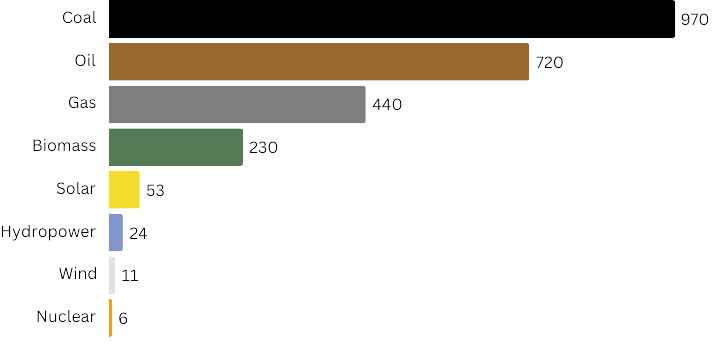Cloud computing might seem intangible, but it consumes electricity through power grids in exactly the same way as a desktop computer or household fridge.
When you use cloud computing, whether sending an email, streaming video, or backing up data, your request must be transmitted to, and processed by, a physical server in a data center somewhere in the world. These servers require a constant power feed, drawn from the data center’s regional power grid and national power stations.
This means that the location of the data center that carries out your cloud computing services has a significant impact on the quantity of carbon that your usage produces. This is because every country, and sometimes the region within that country, has a different grid mix – the mixture of energy sources that power their electricity supply. This can range from a very low-emission grid mix, made up primarily of renewable energy sources, to a very high-emission mix, that largely utilizes fossil fuels.
Electricity Sources – from cleanest to dirtiest
No country uses a single energy source to generate 100% of their electricity. Instead, they use a combination of different sources, as well as importing electricity from abroad. The UK, for example, generates more than half of its electricity through domestic renewables, a third through gas, and the remainder through imports from Europe (as of March 2025, NESO).
Not all renewables are created equal, however. Although their source might be renewable, the energy generation process for some renewables still produces carbon emissions – “renewable” does not mean zero carbon.

Coal: the most carbon-intensive energy source, producing 970 grams of CO2e for every kilowatt-hour of electricity it generates.
Oil: the combustion of oil produces 720 grams of CO2e per kilowatt-hour of electricity.
Gas: the most common non-renewable in Europe and the US, produces 440 grams of CO2e per kilowatt-hour.
Biomass: the dirtiest renewable energy source, which can produce up to 230 grams of CO2e per kilowatt-hour of electricity, depending on the biomass material being combusted. This can include household waste, wood pellets, livestock byproducts, and sewage sludge.
Solar: produces 53 grams of CO2e per kilowatt-hour, due to the carbon footprint of solar panel manufacturing – but this footprint is paid off after 3 years of usage, with the lifespan of a modern solar panel being up to 40 years.
Hydropower: hydroelectric energy generation is responsible for 24 grams of CO2e per kilowatt-hour, due to the resources needed to maintain hydroelectric dams.
Wind: produces just 11 grams of CO2e per kilowatt-hour, due to the carbon footprint of turbine manufacturing and installation.
Nuclear: the cleanest form of renewable energy, producing just 6 grams of CO2e per kilowatt-hour of electricity. These emissions come from the processing of uranium ore.
Energy source carbon intensities from Our World in Data, 2022.
Clean Grid – Switzerland
There are 109 data centers in Switzerland, including multiple centers run by AWS, Azure, and GCP. With one of the cleanest electricity grids in the world, any cloud computing processed through Switzerland’s data centers will be very low carbon.
Switzerland’s Grid Mix:

Carbon Intensity: 49.49 gCO2e /kWh
An AWS m6a.12xlarge cloud instance with 1TB storage being hosted in a data center in Zurich for a year would produce 102.03 gCO2e.
Grid mix and carbon intensities from Ember, 2024-2025.
Dirty Grid – India
India’s electricity grid is still heavily reliant on fossil fuels, as the second largest consumer of coal in the world. The 152 data centers in India therefore have a very high carbon footprint. At the same time, the low cost of data center hosting in India is making it an attractive prospect for increasing numbers of corporations with heavy cloud computing workloads.
India’s Grid Mix:

Carbon Intensity: 670.86 gCO2e /kWh
An AWS m6a.12xlarge cloud instance with 1TB storage being hosted in a data center in Mumbai for a year would produce 1,107.77 gCO2e. That’s a massive 954% more than exactly the same service based in a Swiss data center!
Grid mix and carbon intensities from Ember, 2024-2025.
Zero Carbon Data Centers – a cloudy issue
Cloud Service Providers (CSPs) recognize that their customers are becoming more aware of the environmental impact of cloud services. AWS, Azure, and GCP have all responded by pledging to run zero carbon operations:
AWS: ‘100% of electricity consumed by Amazon was matched with renewable energy in 2023’.
Azure: ‘By 2025, Azure will shift to 100 percent supply of renewable energy, meaning that we will have power purchase agreements (PPA) for green energy’.
GCP: ‘in 2017, Google became the first company of our size to match 100% of its electricity consumption with renewable energy’.
To truly reach zero-carbon, CSPs would have to generate their own 100% renewable energy over a period of years, or only source electricity from countries with 100% renewable grids (of which there are only a handful). Instead, CSPs meet their zero carbon goals by offsetting their actual emissions with renewable energy power purchases.
CSPs can claim to be zero carbon if they match their fossil fuel energy usage with the purchase of the same amount of renewable energy. This means that whilst CSPs are funding the generation of renewable energy, they are not actually replacing their own fossil fuel consumption with renewables. With cloud computing contributing 1% of global emissions – and rising – (IEA, 2023) it is vital that the actual quantity of carbon emissions being produced by CSPs is kept in check.
The Solution – Data Center Migration
One of the most efficient ways to reduce your organization’s carbon emissions from cloud computing is to migrate your cloud services to a lower carbon data center.
As part of its calculation process, Tailpipe tracks the carbon intensity of all CSP data center locations. It does this by matching CSP regions with country-specific carbon intensity measurements from Ember or other, country-specific, grid mix sources. Tailpipe identifies where your organization’s services are based by analyzing your organization’s usage and billing reports. It then compares the carbon intensity of these locations to the intensities of other data centers around the world, to determine whether to recommend a migration.
Migration of services does not necessarily impact your operationality. It can be completed in-house or with the assistance of your CSP or another service provider. In the case of virtual machines, the attached storage (virtual disks) is replicated to the new data center and then attached to a new server. The old server is then turned off and the new server power on, using the data from the replicated disk. Small workloads can often be moved live, but larger ones can take a period of days. An alternative solution is to switch to more efficient server configurations within the same data center, which will use less power, thereby generating fewer emissions.
Find Out More
To find out more about how Tailpipe factors carbon intensity into its cloud service carbon calculations, see the Tailpipe Methodology. If you’re interested in reducing your cloud computing carbon emissions through efficient data center migration, get in touch with us here.
We use cookies to improve your experience on our site. By using our site, you consent to cookies.
Websites store cookies to enhance functionality and personalise your experience. You can manage your preferences, but blocking some cookies may impact site performance and services.
Essential cookies enable basic functions and are necessary for the proper function of the website.
Google reCAPTCHA helps protect websites from spam and abuse by verifying user interactions through challenges.
Statistics cookies collect information anonymously. This information helps us understand how visitors use our website.
Google Analytics is a powerful tool that tracks and analyzes website traffic for informed marketing decisions.
Service URL: policies.google.com (opens in a new window)
Marketing cookies are used to follow visitors to websites. The intention is to show ads that are relevant and engaging to the individual user.
You can find more information in our Cookie Policy and Privacy Policy.
